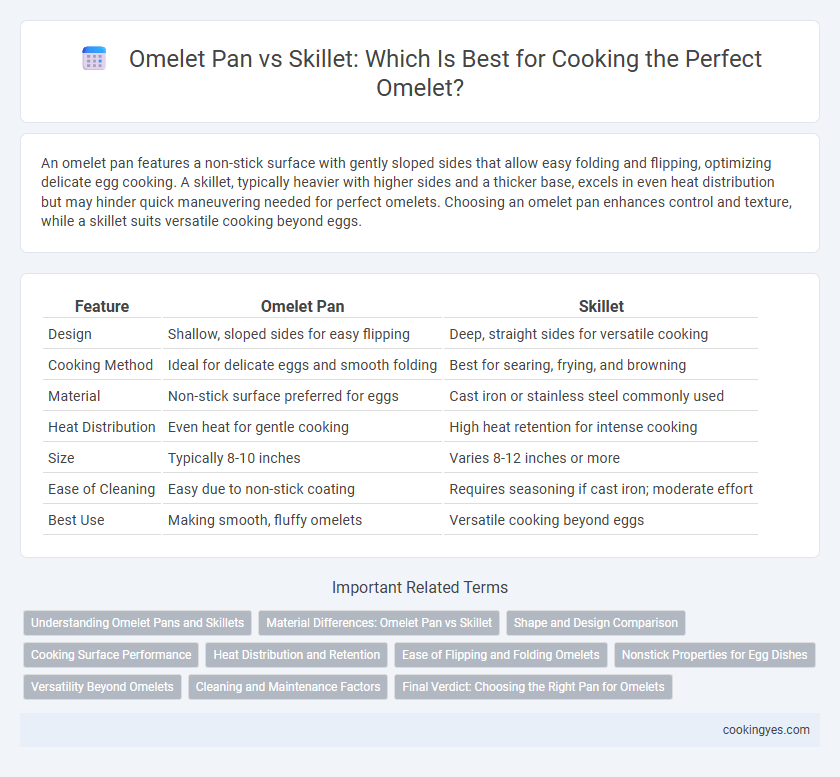An omelet pan features a non-stick surface with gently sloped sides that allow easy folding and flipping, optimizing delicate egg cooking. A skillet, typically heavier with higher sides and a thicker base, excels in even heat distribution but may hinder quick maneuvering needed for perfect omelets. Choosing an omelet pan enhances control and texture, while a skillet suits versatile cooking beyond eggs.
Table of Comparison
| Feature | Omelet Pan | Skillet |
|---|---|---|
| Design | Shallow, sloped sides for easy flipping | Deep, straight sides for versatile cooking |
| Cooking Method | Ideal for delicate eggs and smooth folding | Best for searing, frying, and browning |
| Material | Non-stick surface preferred for eggs | Cast iron or stainless steel commonly used |
| Heat Distribution | Even heat for gentle cooking | High heat retention for intense cooking |
| Size | Typically 8-10 inches | Varies 8-12 inches or more |
| Ease of Cleaning | Easy due to non-stick coating | Requires seasoning if cast iron; moderate effort |
| Best Use | Making smooth, fluffy omelets | Versatile cooking beyond eggs |
Understanding Omelet Pans and Skillets
Omelet pans feature a smaller diameter and non-stick surface specifically designed to cook delicate eggs evenly and facilitate easy flipping, while skillets offer a larger cooking area with higher sides suited for versatile frying and sauteing. The lightweight construction and rounded edges of omelet pans allow for precise control and gentle heat distribution, essential for achieving the perfect fluffy texture. In contrast, skillets provide durability and heat retention, making them ideal for searing and browning, though they may be less optimal for delicate egg dishes like omelets.
Material Differences: Omelet Pan vs Skillet
Omelet pans typically feature non-stick coatings and lightweight aluminum or anodized materials for even heat distribution and ease of flipping delicate eggs. Skillets, often crafted from cast iron or stainless steel, provide superior heat retention and versatility for searing and frying but may require seasoning to maintain a non-stick surface. Material differences affect cooking performance, with omelet pans designed specifically for gentle cooking and skillets offering durability and multi-purpose use.
Shape and Design Comparison
An omelet pan features a shallow, sloped edge design that enables easy folding and flipping of delicate eggs, promoting even cooking and minimal sticking. In contrast, a skillet has higher, straighter sides suited for versatile cooking but can make maneuvering omelets more challenging. The shape of an omelet pan prioritizes precise heat distribution and gentle handling, while a skillet provides more space for sauteing and browning.
Cooking Surface Performance
Omelet pans feature nonstick coatings and gently sloped sides that enhance easy flipping and folding, making them ideal for delicate egg dishes. Skillets, typically made from cast iron or stainless steel, offer superior heat retention and even cooking but require more oil to prevent sticking. The cooking surface performance of an omelet pan optimizes control and precision, while skillets excel in versatility and browning capability.
Heat Distribution and Retention
Omelet pans are typically made with non-stick coatings and lightweight aluminum, offering quick, even heat distribution ideal for delicate cooking. Skillets, often constructed from cast iron, excel in heat retention, maintaining steady temperatures for prolonged cooking but may heat less evenly at first. For precise omelet preparation, the faster, more uniform heat of an omelet pan prevents sticking and uneven cooking compared to the skillet's slower heat response.
Ease of Flipping and Folding Omelets
Omelet pans typically feature a nonstick surface and low, sloped sides that allow effortless flipping and precise folding of delicate omelets without tearing. Skillets, while versatile, often have higher sides and heavier weight that can make maneuvering the omelet more challenging during flipping. Choosing an omelet pan enhances cooking control, ensuring smooth, evenly cooked omelets with perfect folds.
Nonstick Properties for Egg Dishes
Omelet pans feature superior nonstick coatings specifically designed for delicate egg dishes, ensuring effortless flipping and minimal oil usage. Skillets often have thicker surfaces that may retain heat unevenly, increasing the risk of eggs sticking and tearing. Choosing an omelet pan with a high-quality nonstick surface enhances cooking precision and cleanup efficiency for fluffy, perfectly cooked eggs.
Versatility Beyond Omelets
An omelet pan offers a non-stick surface and curved edges specifically designed for easy folding and flipping of delicate eggs, enhancing omelet preparation. Skillets, with their thicker construction and flat sides, provide superior heat retention and versatility for searing, sauteing, and frying a wider variety of foods beyond omelets. Choosing between an omelet pan and a skillet depends on whether you prioritize specialized egg dishes or broader cooking applications in your kitchen.
Cleaning and Maintenance Factors
Omelet pans typically have non-stick coatings that simplify cleaning by preventing egg residue from sticking, making maintenance faster and less labor-intensive. Skillets, especially cast iron, require seasoning and careful drying to avoid rust, demanding more time and effort for upkeep. Regular use of gentle cleaning tools and avoiding abrasive scrubbers preserves the pan's surface, ensuring long-term durability for both cookware types.
Final Verdict: Choosing the Right Pan for Omelets
Omelet pans with non-stick coating and sloped sides offer precise temperature control and easy folding, making them ideal for delicate omelets. Skillets provide versatility and higher heat retention but may cause sticking without proper seasoning, which can compromise the omelet's texture. For the best omelet cooking method, a specialized omelet pan ensures consistent results and effortless flipping.
Omelet pan vs Skillet for cooking method Infographic

 cookingyes.com
cookingyes.com